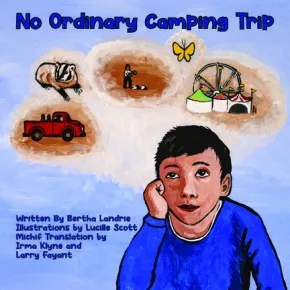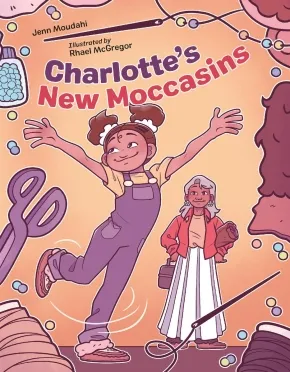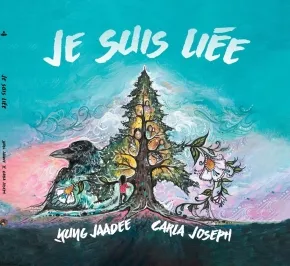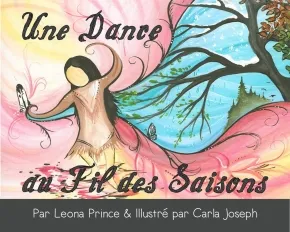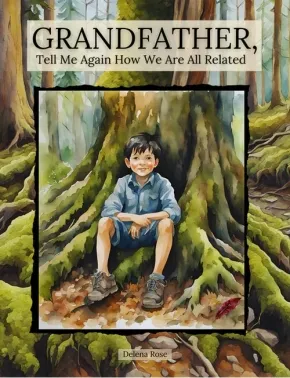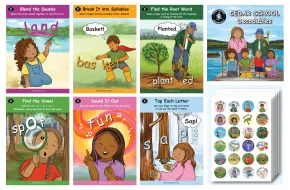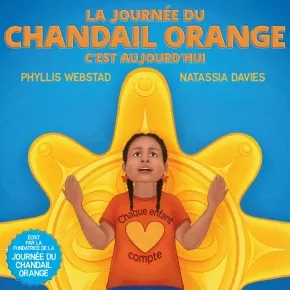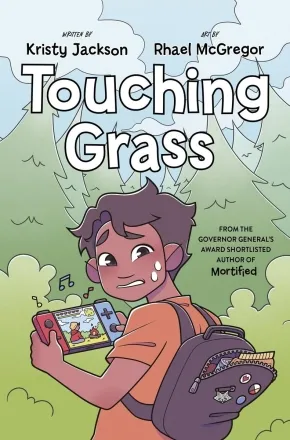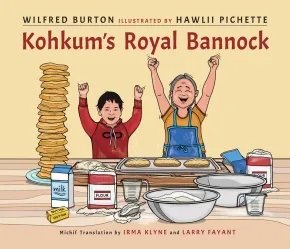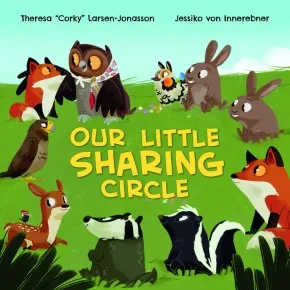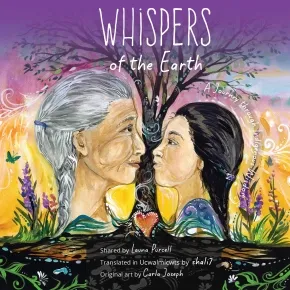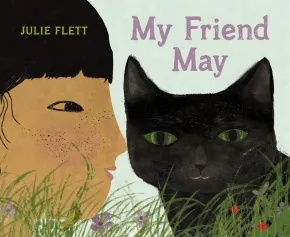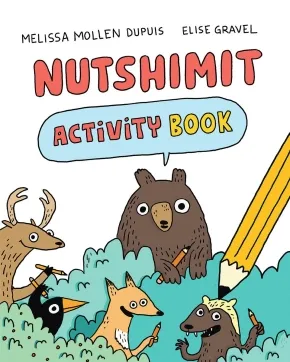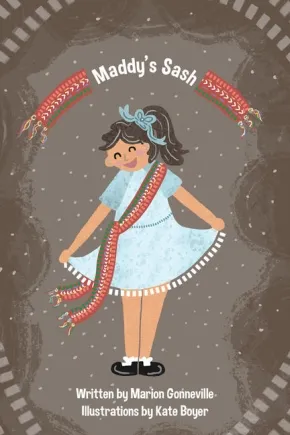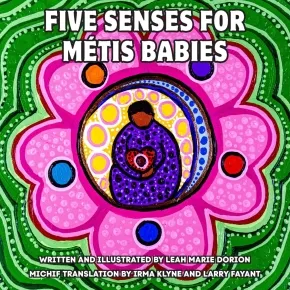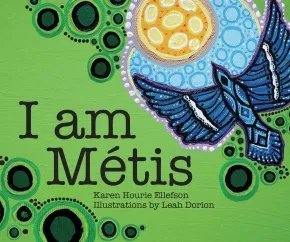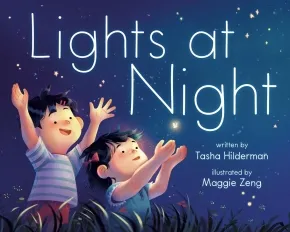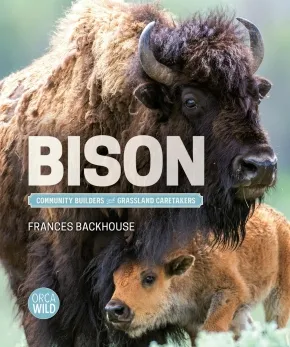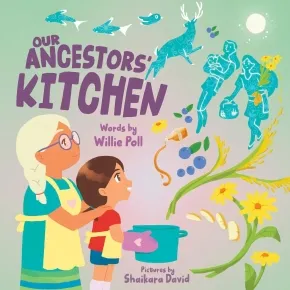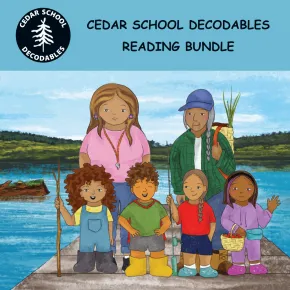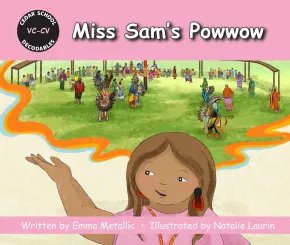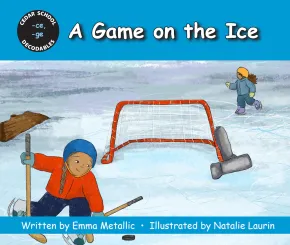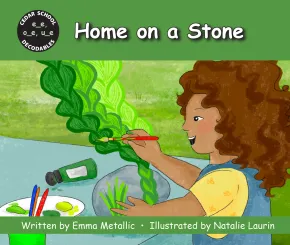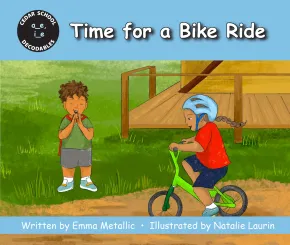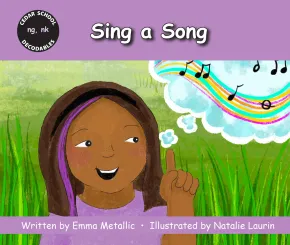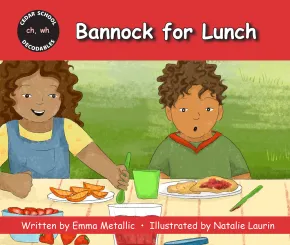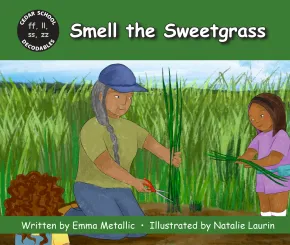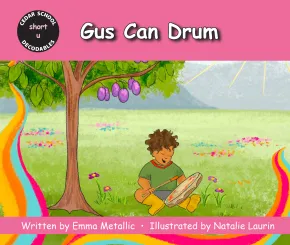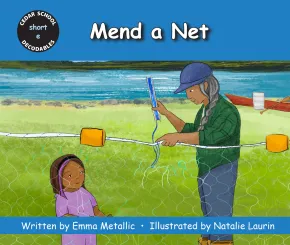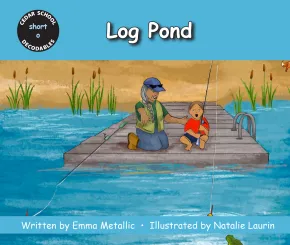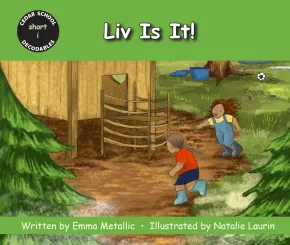
Métis
1
-
15
of
225 Results;
Sort By
Go To
of 15
I Am a Sixties Scoop Warrior
$17.95
Format:
Paperback
Text Content Territories:
Indigenous Canadian; Métis;
ISBN / Barcode: 9781774569153
Synopsis:
Synopsis:
The Sixties Scoop is a dark part of Canada's history. Learn more about this time from someone who lived it. Jacqueline tells us more about her time as a child in the Sixties Scoop.
Educator Information
Juvenile Nonfiction
Additional Information
24 pages | Paperback
Road Allowance Kitten: Full Circle
$17.50
Artists:
Text Content Territories:
Indigenous Canadian; Métis;
ISBN / Barcode: 9781988011370
Synopsis:
Synopsis:
In Road Allowance Kitten: Full Circle, Madeline, Rosie, and their cat, Kitten continue to share adventures. This time with a visit to a circus. However, Madeline is unexpectedly diagnosed with tuberculosis and is sent to a sanitarium to recover; sadly, a common experience for Indigenous Peoples in the early twentieth century. While healing there, Madeline resumes her friendship with Rosie and Kitten, albeit from a distance, and the trio demonstrates the enduring strength of true friendship and the importance of hope when faced with adversity. The family finds itself full circle, back on a road allowance in the valley so they can be closer to Madeline.
Richly steeped in Michif culture and vividly illustrated by Christina Johns, this uplifting story leaves young readers with a strong impression of Métis resilience and pride. Road Allowance Kitten: Full Circle is a welcome addition to Wilfred Burton’s acclaimed historical fiction series, which includes Road Allowance Kitten and Road Allowance Kitten: Broken Promises.
Educator & Series Information
Dual-language: English and Michif
Translation by Larry Fayant and Irma Klyne
Additional Information
39 Pages | 8.5” x 11” | Paperback
No Ordinary Camping Trip
$17.50
Artists:
Format:
Paperback
Text Content Territories:
Indigenous Canadian; Métis;
ISBN / Barcode: 9781988011363
Synopsis:
Synopsis:
In No Ordinary Camping Trip, Bertha Landrie recounts a tale from her husband, Joe’s, childhood. Many Métis families relied on seasonal employment, working for farmers, clearing fields, picking Seneca root, and other labour jobs to support themselves. In this coming-of-age story, a young Joe works hard picking rocks in order to make money to go to the North Battleford Fair. Will they be able to finish the job in time? Lucille Scott’s evocative illustrations take us back in time while capturing the story’s essence. Michif Old Ones, Irma Klyne and Larry Fayant provide a Southern Michif translation—the language of the Landrie family.
Reviews
"Rich in cultural detail, the story introduces young readers to aspects of Métis culture and values. The book celebrates themes of family, resilience, and identity. Suitable for grades three to five Social Studies and Language Arts, it supports curricular goals related to Indigenous perspectives, cultural diversity, and belonging, while promoting early bilingual literacy through its inclusion of Michif. Narrations in English and Michif are available through a link provided by the publisher, and supplementary information about the Road Allowance period in Métis history is also provided." - Bonny-Lynn D., Elementary School Teacher, Indigenous Books for Schools
Educator Information
Recommended for Grades 3 to 5.
Dual-language format: Michif and English.
Themes: Childhood; Coming of Age; Family; Intergenerational Roles
This title is included in the Indigenous Books for Schools database from the Association of Book Publishers of BC. It's recommended for Grades 3 to 5 for English Language Arts and Social Studies.
Additional Information
37 Pages | 9" x 9" | Paperback
A Salmon Story: Protecting the Future
$22.95
Artists:
Format:
Hardcover
Text Content Territories:
Indigenous Canadian; First Nations; Salish; Interior Salish; St'at'imc (Lillooet, Lil'Wat);
ISBN / Barcode: 9781771476461
Synopsis:
Synopsis:
A lyrical informational picture book about how open-net pen fish farms impact wild salmon and their ecosystems
Salmon are central to their ecosystem and the lives of many Indigenous Nations, but the rapid rise of open net-pen fish farming has threatened these longstanding connections. Salmon have followed the same migration routes for thousands of years, but the fish farming industry has had a deadly impact on their annual journey. Open-net pen farms release harmful waste into the ocean that is lethal to the wild salmon forced to swim through it. Now, the salmon must battle against the human-made destruction of their habitat, and many Nations are advocating for change and creating calls of action to protect salmon for future generations.
As the young salmon journey from their gravel nests to the open ocean, readers learn about the life cycle of wild salmon, the effects of open-net pen fish farms, and the role of salmon as a keystone species.
Boldly illustrated with gorgeous Northwest Coast formline art, rhythmic poetry combines with supportive nonfiction content to illuminate the struggles faced by wild salmon populations.
Educator Information
Recommended for ages 5 to 8.
Fountas & Pinnell Text Level Gradient: J
Lexile measure: 980L
Additional Information
40 pages | 10.00" x 8.50" | Hardcover
Charlotte's New Moccasins
$21.99
Artists:
Format:
Hardcover
ISBN / Barcode: 9781623544966
Synopsis:
Synopsis:
Charlotte has outgrown her moccasins! Still, there's nothing a trip to Grandma's can't fix in this heartwarming intergenerational story.
A sweet, celebratory picture book about family and culture by two debut Métis creators centered around Indigenous peoples' tradition of making moccasins, perfect for 3-7-year-olds.
Charlotte has outgrown her moccasins, so she and her Mom head to Grandma's for new ones. Grandma teaches Charlotte how to make her new mocs step-by-step, and she learns a valuable skill from her beloved elder in this heartwarming multigenerational story.
A contemporary celebration of Native culture, tradition, and family. A highly-relatable story for Indigenous kids and any kid that has ever outgrown their favorite thing to wear.
Back matter includes details about moccasins then and now, some additional facts about them, and information about how they have been made over time.
Educator Information
Recommended for ages 3 to 7.
Additional Information
32 pages | 9.00" x 11.31" | Hardcover
Je suis liée
$22.95
Artists:
Format:
Hardcover
Text Content Territories:
Indigenous Canadian; First Nations; Haida;
ISBN / Barcode: 9781778540752
Synopsis:
Synopsis:
Chaque personne est liée. Qu’il s’agisse de vos relations familiales, du contact de vos pieds avec le sol ou des conseils bienveillants de vos ancêtres, vous avez des liens avec tout ce qui vous entoure. Sur fond d’époustouflants paysages de Haida Gwaii, la conteuse Kung Jaadee vous invite à découvrir les nombreux liens qui nous unissent à travers le temps et l’espace. Quels sont vos liens?
Educator Information
Recommended for ages 6+.
This book is available in English: I am Connected.
Additional Information
28 pages | 1.40" x 2.40" | Hardcover
Une Danse au Fil des Saisons
$20.95
Artists:
Format:
Paperback
Text Content Territories:
Indigenous Canadian; First Nations; Dene; Dakelh (Carrier);
ISBN / Barcode: 9781068868689
Synopsis:
Synopsis:
Alors que les adultes se débattent avec une décision importante concernant l'avenir de leur communauté, la Jeune Femme reçoit la solution en rêve. Cependant, les adultes ne reconnaissent pas la sagesse de la Jeune Femme. Découragée, elle entreprend un voyage d'un an vers la découverte de soi et la résilience. Guidés par Tortue, ils traversent les saisons en utilisant les pratiques traditionnelles du peuple Dakelh (Porteur). Un an plus tard, la Jeune Femme revient avec plus de connaissances que jamais, mais les adultes la laisseront-ils déterminer leur avenir ?
Educator Information
Recommended for Grades 2 - 7.
This book is available in English: A Dance Through the Seasons.
Additional Information
10.50" x 8.25" | Paperback
The Cedar Mother
$24.95
Artists:
Format:
Hardcover
Text Content Territories:
Indigenous Canadian; First Nations; Gitxsan (Gitksan);
ISBN / Barcode: 9781774921586
Synopsis:
Synopsis:
From small sapling to towering giant, follow the long life of a cedar tree in this illustrated book for young scientists.
Step outside to explore the hidden mysteries of the cedar tree life cycle in this beautifully illustrated, engaging non-fiction book for young scientists ages 9 to 12.
Meet Nox Sim Gan, the cedar mother, whose life cycle spans centuries and whose roots anchor the landscape. The cedar mother plays a vital role in the ecosystem: offering shelter for birds in her strong limbs, providing refuge for small creatures beneath her bark, and healing the Gitxsan with a medicinal tea made from her soft, green leaves. She also creates the very oxygen that all land-dwelling creatures need to breathe.
Delve into the remarkable story of the western red cedar as you learn how she nourishes herself through an unexpected connection to salmon, the secret web of life that thrives beneath the ground, and how, at the end of her life, she leaves a final gift for the Gitxsan. This book invites young readers to discover the life of a tree that is much more than meets the eye, offering lessons in interconnectedness, and in wisdom passed down through generations.
Educator & Series Information
Recommended for ages 9 to 12.
Lexile measure: 1050L
This book is part of the Mother of Xsan series, which uses striking illustration and lyrical language to bring the poetry of the Xsan ecosystem to life. It is the eighth book in the series.
Additional Information
32 pages | 6.50" x 10.00" | Hardcover
Grandfather, Tell Me Again How We Are All Related
$17.95
Artists:
Format:
Paperback
Text Content Territories:
Indigenous Canadian;
ISBN / Barcode: 9781069189509
Synopsis:
Synopsis:
A grandfather teaches his grandson how we are all related to plants, insects, birds and animals—and that each of us has a place in the sacred web of life.
Educator Information
Recommended for ages 7 to 12.
Additional Information
38 Pages
Cedar School Decodables with Stickers Sheets and Posters
 $190.70
$190.70

Text Content Territories:
Indigenous Canadian; First Nations; Mi'kmaq (Mi'gmaq);
Grade Levels: Kindergarten; 1;
ISBN / Barcode: n/a
Synopsis:
Synopsis:
This bundle includes the following Cedar School Decodables resources:
- All 20 titles in the Cedar School Decodables series
- Cedar School Decodables Sticker Sheets: Words of Encouragement (Set of Five)
- Cedar School Decodables Posters: Decodable Reading Strategies (Set of Six)
About the Cedar School Decodables Series
Welcome to Cedar School! Join Liv, Tom, Gus, and Bell as they learn on the land and explore Mi’gmaw teachings with their teacher, Miss Sam, and the school’s Mi’gmaw Elder, Jen. With charming illustrations and simple storylines, this decodable series engages students as they practise their reading skills. Each book includes a pre-reading review of non-decodable words, and many of the books introduce special words related to Indigenous teachings. Talking Together prompts facilitate discussions led by the reading teacher.
Developed in partnership with Dyslexia Canada, Cedar School Decodables is a series of 20 decodable books for young readers. Designed for students who have previously learned short vowel and consonant sounds, additional phonic skills are developed progressively throughout the series. Cedar School Decodables is divided into six sets, which increase in word count and complexity of sentence structure:
Set 1 – Short Vowels (40-60 words)
Set 2 – Digraphs (60-80 words)
Set 3 – VCe (80-90 words)
Set 4 – Longer Words (90-100 words)
Set 5 – Ending Spelling Patterns (100-110 words)
Set 6 – R-Controlled Vowels (110-125 words)
This series is recommended for ages 4 to 7 for use in kindergarten and Grade 1 classrooms.
Each book is 16 pages | 6.5” x 5.5” | Paperback
About the Stickers and Posters
Students will love seeing familiar faces from the Cedar School Decodables series as you use the Words of Encouragement stickers and Decodable Reading Strategies Posters to support your structured literacy approach.
The Decodable Reading Strategies Posters share six strategies that students can use to decode new words.
The Words of Encouragement stickers can be used to reinforce learned reading skills, make daily lessons fun and engaging, and celebrate students’ success and achievements.
Scroll below to learn more about the resources included in this bundle. Resource availability may fluctuate.
La Journée du chandail orange, c'est aujourd'hui (BB)
$14.95
Artists:
Format:
Board Book
Text Content Territories:
Indigenous Canadian; First Nations; Salish; Interior Salish; Secwepemc (Shuswap); Stswecem'c Xgat'tem;
Grade Levels: Preschool;
ISBN / Barcode: 9781778540677
Synopsis:
Synopsis:
Aujourd'hui, nous nous rassemblons
Aujourd'hui, nous écoutons
Aujourd'hui, nous apprenons
Aujourd'hui, nous ouvrons nos coeurs
Une première conversation sur l'importance de la Journée du chandail orange – Chaque enfant compte et permet aux tout-petits de savoir ce qu'ils peuvent s'attendre à voir et à faire lors de la Journée du chandail orange – Journée nationale pour la vérité et la réconciliation.
Un tout-carton authentique et adapté à l'âge, conçu pour les enfants de 0 à 3 ans, écrit par la fondatrice du mouvement La Journée du chandail orange et auteur du livre d'images primé « Chaque enfant compte ».
La Journée du chandail orange est reconnue chaque année le 30 septembre pour honorer les survivants des pensionnats indiens, leurs familles et les enfants qui ne sont pas rentrés.
Educator Information
Recommended for ages 3 and under.
This book is available in English: Today is Orange Shirt Day (BB)
Additional Information
24 pages | 7.00" x 7.00" | Board book
Touching Grass
$21.99
Artists:
Format:
Hardcover
Text Content Territories:
Indigenous Canadian; First Nations; Dene;
ISBN / Barcode: 9781443472234
Synopsis:
Synopsis:
From the author of the Governor General’s Award shortlisted, Silver Birch Award finalist Mortified, a funny, heartfelt middle-grade novel about a young gamer who is sent to “touch grass” at a Dene First Nation culture camp.
Tristen would do anything to avoid going outside. The bugs sting, the snakes are poisonous, the heat will kill you if the cold doesn’t, and bodies of water? Forget it. Tristen likes it best indoors, deep in his online world where it’s safe, with his online friends. Something he has a hard time with IRL.
But Tristen is in trouble at school again, and the principal is threatening to kick him out of this third school in two years. His mom believes the answer is to get Tristen off the games and in touch with nature and his Dene roots. This means Tristen has to spend a week to a culture camp in the wilderness. It’s his worst nightmare!
And at first it is a nightmare—no internet, no phone reception, no Bepsi!—and Tristen has no idea how to do any of the skills the other kids seem to do easily. But soon, with some surprising new friends and a few patient teachers, and a little help from technology, Tristen begins to think he might be able to hack this nature stuff after all.
Reviews
“I think it’s so important for kids to see themselves in books, and our area isn’t often included. I think kids from the north who read this will feel included. I think they will laugh when they read it. I sure did.”— Ronelda Robillard, Hatchet Lake Denesu?line´ First Nation, Treaty 10
"I am Dene, and I come from an Athabasca Dene community. I endorse Touching Grass. This book, with its themes of resilience, survival, and the importance of community, resonates deeply with the Saskatchewan community. . . . We would love kids everywhere to read it!” — Rosalie Tsannie-Burseth, Hatchet Lake Denesu?line´ First Nation, Treaty 10
"Reminiscent of Ruby Slipperjack's Little Voice and Lee Maracle's Will's Garden, Touching Grass is a story readers are going to love. If you're a fan of the Joey Pigza series, you'll feel right at home with Tristen with his innocent heart and sizzling energy. I loved every part of his journey. Wow. What a fun read." — Richard Van Camp, author of The Lesser Blessed and Beast
Educator Information
Recommended for ages 8 to 12.
Additional Information
336 pages | 5.50" x 8.25" | 30 b&w illustrations | Hardcover
Across the Ice: How We Saved the Ojibwe Horse
$24.99
Artists:
Format:
Hardcover
Text Content Territories:
Indigenous Canadian; First Nations; Anishinaabeg; Ojibway; Saulteaux; Lac La Croix First Nation (Gakijiwanong);
ISBN / Barcode: 9781536229455
Synopsis:
Synopsis:
Discover the history of the endangered Ojibwe horse and the daring intervention of the Lac La Croix First Nation in this celebration of community, tradition, courage, and hope.
It’s a cold, snowy night at Lac La Croix First Nation, and two siblings are too excited to fall asleep. The horses are coming tonight! Amid the buzz of aunties and uncles and cousins, Nookomis tells a story that began many years ago, when their people shared the land with herds of wild ponies. In a symbiotic relationship, the people provided the horses with food and shelter, while the horses helped them run traplines and travel. But after many years had passed, and the herd had dwindled to four, the government threatened to shoot them. It was time to move the remaining horses to safety—but getting them there would be harder than they thought! Follow the true story of a “heist across the ice” from Ontario to Minnesota and learn how a small herd of hardy, indigenous horses returned years later to their native land. Rich illustrations honor the life of the Ojibwe people over time, as well as the land and living things that have survived under their stewardship.
Educator Information
Recommended for ages 3 to 7.
Additional Information
32 pages | 9.62" x 10.62" | Hardcover
Kohkum's Royal Bannock
$14.95
Artists:
Format:
Paperback
Text Content Territories:
Indigenous Canadian; Métis;
ISBN / Barcode: 9781771872744
Synopsis:
Synopsis:
This beautifully illustrated Métis picture book is fully bilingual in Michif and English. A feast for the eyes and a tickle for the funny bone, Kohkum cooks up a HUGE order of bannock in her own kitchen, for the Queen and 299 guests!
This lively and whimsical tale begins with a letter from the government asking Kohkum to cook bannock for the Royal visit. Kohkum's grandson Xavier is as excited as she is, until they do the math and are shocked to learn that they are cooking not just for the Queen but for her entourage and guests too. A mad scramble ensues, with a rushed trip to the grocery store to buy a ridiculous amount of flour and milk, and a perilous trip home with the car stuffed with supplies and Xavier riding on the roof. Several aunties come to the rescue, helping with bannock assembly and sharing in the excitement of cooking for the Queen.
Written by an educator, this story provides many opportunities to count in English and Michif, with many laughs along the way as Kohkum, aunties, and Xavier scramble to cook the bannock in time for the Queen's visit. Boldly colourful, humourous illustrations by illustrator Hawlii Pichette bring this entertaining story to life. Full translation makes this book ideal for in-class cultural learning and Michif language acquisition.
Educator Information
Recommended for preschool to Grade 4.
Bilingual: Michif and English
Michif Translation by Irma Klyne and Larry Fayant.
Additional Information
32 pages | 10.50" x 9.00" | Paperback
One Beaded Earring
$8.95
Artists:
Format:
Paperback
Text Content Territories:
Indigenous Canadian; Métis;
ISBN / Barcode: 9781459841598
Synopsis:
Synopsis:
Delia’s mom has the most beautiful earrings.
They’re long and dangly earrings, and made from strands upon strands of tiny blue, green and white beads that make the earrings look like waterfalls. Delia decides to wear the earrings to school to show off a little to her friends. And it works—until one earring falls down the drain in the school bathroom.
When Delia confides in her grandmother about the lost earring, she learns that she can’t just replace it: her Aunt Maureen made the earrings for her mother to celebrate getting their Métis citizenship. Delia didn’t even know her family was Métis! With no way to replace the lost earring, Delia must own up to her mistakes, dive deeper into her Métis identity and use her storytelling skills to find a way to make things right.
Educator & Series Information
Recommended for ages 6 to 8.
Fountas & Pinnell Text Level Gradient: N
Lexile measure: 610L
Flesch-Kincaid Grade Level: 3.5
Guided Reading Level: N
This book is part of the Orca Echoes series.
Includes a Michif glossary.
Additional Information
96 pages | 5.25" x 7.62" | 27 b&w illustrations | Paperback
Our Little Sharing Circle (BB)
$13.95
Artists:
Format:
Board Book
Text Content Territories:
Indigenous Canadian; First Nations;
ISBN / Barcode: 9781778540769
Synopsis:
Synopsis:
In our little sharing circle…We care…We share… Our Little Sharing Circle is a gentle introduction to sharing, listening, and learning in the sharing circle. Our Little Sharing Circle is based on the bestselling picture book, The Sharing Circle.
Educator Information
Recommended for ages 3 and under.
This book is based on the picture book The Sharing Circle.
Additional Information
10 pages | 6.00" x 6.00" | Board Book
Celebrating Potlatches
$21.95
Artists:
Format:
Hardcover
Text Content Territories:
Indigenous Canadian; First Nations; Tsimshian (Ts'msyen); Nisga'a;
ISBN / Barcode: 9781771746564
Synopsis:
Synopsis:
“Papa, what is a Potlatch?”
Inspired by Ts’msyen Chief William Beynon’s historic notebooks on Potlatches in the Gitxsan village of Gitsegukla, Celebrating Potlatches pairs intergenerational storytelling with beautiful illustrations to honour Indigenous traditions. From the award-winning author of Oolichan Moon and the accomplished illustrator of Be a Good Ancestor, this book recounts the 1885 Potlatch ban and the resilience of the communities who fought to keep their traditions alive.
Reviews
“Heartfelt and timely, Celebrating Potlatches gifts readers with cultural teachings through an intergenerational account of Indigenous resilience. This book is a beautiful tribute to the author’s great-grandfather, William Beynon, whose life’s work documenting oral histories of Sm’algya̱x-speaking Peoples and their Potlatches continues to be foundational to our cultural resurgence today.” – Sm Łoodm ‘Nüüsm (Dr. Mique’l Dangeli), Sm’algya̱x language expert and Assistant Professor of Indigenous Arts at the University of Victoria
“This beautiful book shares the importance of community, culture, and identity. As you make your way through the pictures and words, they bring you to an understanding of how important the Potlatch ceremony was and continues to be for Indigenous Peoples.” – Carolyn Roberts, educator, speaker, and author of Re-Storying Education
Educator Information
Recommended for ages 4 to 8.
Through this conversational historic account, readers can learn alongside the narrator as his Papa shares his wisdom about the rich history of the Potlatch.
Curriculum Connections
- Early literacy – listening, reading, and discussing
- Art – traditional Indigenous art, drumming, and regalia
- Social studies – the 1885 Potlatch ban, history of Indigenous Peoples, connection to community
- Social responsibility – uplifting ourselves and others, honouring traditions
- Indigenous knowledge and traditions – traditional teachings, Potlatch ceremonies, intergenerational storytelling
Two free, downloadable lesson plans—one for kindergarten to Grade 1 and one for Grades 2 to 3—provide connections to Social Studies curriculum.
Additional Information
32 Pages | 10" x 8.5" | Hardcover
All My Relations
$19.95
Artists:
Format:
Hardcover
Text Content Territories:
Indigenous Canadian;
ISBN / Barcode: 9781779550118
Synopsis:
Synopsis:
All My Relations is a rhyming story of appreciation for the connections and relationships we have to the world around us. This book creates opportunities for conversations and connections with Mother Earth and each other; The Swimmers, The Crawlers, The Four-Legged, The Two-Legged, and All Our Relations.
Educator Information
Recommended for grades 1 to 3.
Additional Information
14 Pages | Hardcover
Whispers of the Earth: A Journey through Indigenous Wisdom
$29.00
Artists:
Format:
Paperback
Text Content Territories:
Indigenous Canadian; First Nations; Salish; Interior Salish; St'at'imc (Lillooet, Lil'Wat);
ISBN / Barcode: 978-1-73869-534-8
Synopsis:
Synopsis:
Prepare to embark on a journey rich with the wisdom of our ancestors and the secrets shared by Mother Earth.
In this children’s book, you will follow a path once tread by those before us, where the songs of the trees, the dance of the rivers, and our stories are carried by the wind. These teachings are invaluable treasures passed down through generations.
You’ll discover the language of animals, the lessons of plants, and the wisdom of the land. If you listen closely, you will hear the “Whispers of the Earth,” guiding you on this incredible adventure.
Educator Information
Recommended for kindergarten to grade 7.
Carl Sam advised on the language, and is “Ha7li” of the Bear Clan from Skookumchuck, part of St’at’icmulh Nation, sometimes referred to as the Interior Salish. Through this book, he shares elements of the Ucwalmícwts language.
Includes some words in Ucwalmícwts.
Additional Information
60 pages | 20 × 20 × 1 cm | Paperback | Printed locally on 100% post-consumer recycled paper.
Maggie Lou Meets Her Match
$14.99
Format:
Paperback
Text Content Territories:
Indigenous Canadian; Métis;
ISBN / Barcode: 9781773067742
Synopsis:
Synopsis:
In this sequel to Maggie Lou, Firefox, the irrepressible Maggie Lou acquires a new cousin, and a horse - both of whom have minds of their own.
When Uncle Bobby gets married, Maggie Lou suddenly finds herself with a new cousin, Rosie. Rosie is the same age as Maggie. She also has a fabulous head of curls, although hers are red. And Rosie knows everything about horses and riding - something Maggie Lou has longed to do.
A rivalry sparks between the girls from the start at Uncle Bobby and Aunt Bonnie's wedding, which features an all-you-can-eat dessert table, as well as lots of energetic dancing. On Rosie's horse farm, Maggie experiences her share of humiliations as she learns how to ride on a pony so short that her feet can touch the ground.
Eventually the cousins become allies and wreak some hair-raising mischief, including a secret midnight horseback ride. And in the end they are joined by friends and family to train, hilariously, for the famous Otipîm'sowak Race - a Métis voyageur relay - carrying on a family tradition.
Throughout it all, Maggie remains stubborn and enthusiastic, as she navigates the new challenges of defeat, rivalry and family change.
Reviews
"A high-energy love letter to rambunctious girls, big families, and Métis culture." — Kirkus Reviews, June 2025
"Full of hilarious high jinks yet bursting with heart ... This book shines with realistic sibling relationships, funny dialogue, strong intergenerational bonds, and a steadfast connection to community and culture."— Booklist, July 2025
Educator & Series Information
Recommended for ages 9 to 12.
This book is the second book in the Maggie Lou series.
Key Text Features: chapters; character drawings; dialogue; glossary; illustrations.
Additional Information
228 pages | 5.00" x 7.50" | b&w illustrations | Paperback
My Friend May
$23.95
Artists:
Format:
Hardcover
Text Content Territories:
Indigenous Canadian; First Nations; Cree (Nehiyawak);
ISBN / Barcode: 9781778401718
Synopsis:
Synopsis:
From the winner of the New York Times Best Illustrated Book Prize and the American Indian Youth Literature Award
I’d like to tell you a rather true story about a big black cat who started out gray. Her name was May.
Margaux and her cat May became friends when Margaux was just six years old. They grew up together, sharing countless memories along the way. But one day, May is late coming home. Where is May? Is she under the porch? Maybe on the roof?
Margaux’s nitôsis (the Cree word for auntie) helps search for May in the tall grass. But soon nitôsis needs to leave: she’s moving away to the big city, and has to pack her things into boxes. Margaux helps nitôsis, but she can’t take her mind off May. Will she ever return? nitôsis is worried, too. But little do they know, May has a surprise in store for both of them!
This fun and heartwarming story with a surprise happy ending invites readers to share their own cat stories. My Friend May is a tribute to love and the balance between all beings, and the experiences and emotions that connect us all.
My Friend May features:
- A glossary of Cree words used throughout the book
- Backmatter content that includes a pronunciation guide
Reviews
"A quiet yet affectionate tribute to familial relationships of all stripes….Cat lovers… will particularly enjoy this sweet tale."—Kirkus Reviews
"From a talented picture book creator….Readers can reflect on great stories of their own encounters with beloved animal friends and share their tales with others….delightful.”—School Library Journal
"Award-winning author Julie Flett has created another beautiful story, perfect for read-alouds in kindergarten to grade three classrooms.... This heartwarming tale gently explores themes of love, loss, and reunion. With Flett’s signature artwork and tender storytelling, My Friend May will resonate with readers of all ages and spark connections to their own stories of friendship and change." - Debra H., Elementary School Teacher, Indigenous Books for Schools
Educator Information
Recommended for ages 4 to 8.
This title is included in the Indigenous Books for Schools database from the Association of Book Publishers of BC as a recommended resource for K to 3 English Language Arts.
Additional Information
40 pages | 11.00" x 9.00" | Hardcover
Nutshimit: Activity Book
$18.99
Artists:
Format:
Paperback
Text Content Territories:
Indigenous Canadian; Métis; Inuit; First Nations; Innu (Montagnais-Naskapi);
ISBN / Barcode: 9781039711778
Synopsis:
Synopsis:
Add your favourite toppings to the bannock, draw some animals that live in the woods and write down a joke that would make cranky Wolverine laugh!
With almost 90 big pages of creative fun based on the bestselling Nutshimit: In the Woods, written by Melissa Mollen Dupuis and illustrated by Elise Gravel, this activity book encourages children to learn and have fun with nature.
Includes colouring pages, word searches, connect-the-dots, picture-prompts, spot-the-differences, DIY comic pages and much more to keep young forest enthusiasts engaged and entertained.
Educator Information
Recommended for ages 6 to 8.
Find the accompanying book here: Nutshimit: In the Woods
This activity book is available in French: Nutshimit: Le cahier d'activités
Additional Information
96 pages | 8.01" x 9.99" | Paperback
On y va!
$21.95
Artists:
Format:
Hardcover
Text Content Territories:
Indigenous Canadian; First Nations; Cree (Nehiyawak);
ISBN / Barcode: 9782897771706
Synopsis:
Synopsis:
Chaque jour, un petit garçon regarde des enfants passer en planche à roulettes et rêve de les rejoindre. Un jour, sa mère lui apporte une surprise : sa vieille planche, juste pour lui ! haw êkwa ! On y va ! Ensemble, ils le font, pratiquant sur le trottoir, au parc — partout. Mais quand vient le moment de pratiquer au parc, les planchistes dévalent les pentes comme une cascade. Pourra-t-il trouver la confiance pour les rejoindre?
Reviews
“L’album s’installe dans la chaleur de ce partage, et dans l’ivresse de leur essor. Il suit l’évolution d’un garçon d’abord paralysé par la timidité, puis électrisé par la confiance en soi.”— Télérama
“Julie Flett signe ici un somptueux quatrième album qui regorge d’émotions et qui fait honneur à l’amitié et à la persévérance. Avec ses pastels, Julie Flett exprime aussi la joie de vivre, le plaisir de s’exercer à ce sport, à cette passion qu’elle aime partager avec ses lecteur·rice·s!”— Lu et partagé
“La liberté de la déambulation en skateboard faite livre. [...] Crie-métisse, l’autrice-illustratrice Julie Flett mêle l’apprentissage de l’exercice d’un sport à celle d’une langue.”— Maze
Educator Information
Recommended for ages 6 to 8.
Curriculum Connections: Sports / Indigenous Languages / Community / Goal-Setting / Risk-Taking / Self-Awareness / Self-Confidence
This book is available in English: Let's Go! haw êkwa
Additional Information
44 pages | 11.00" x 9.00" | Hardcover
Maddy's Sash
$17.50
Artists:
Format:
Hardcover
Text Content Territories:
Indigenous Canadian; Métis;
ISBN / Barcode: 978-1-988011-35-6
Synopsis:
Synopsis:
Maddy’s Sash, by Marion Gonneville, with illustrations by Kate Boyer, is the story of a young girl who connects with her Métis roots while she spends time with her Moshôm, Kohkom and their special dog Max. Maddy has many adventures at her grandparents’ farm in northern Saskatchewan, including an exciting berry picking adventure, a dramatic canoe trip, and a rollicking barn dance.
Reviews
"Maddy’s Sash is a wonderful read-aloud for classrooms, especially when exploring Métis culture and heritage. When Maddy visits her moshôm and kôhkom (her grandpa and grandma), she learns about her family’s roots by joining in cultural activities that are part of their daily life. Maddy bonds with a big Newfoundland dog named Max and helps care for a newborn chick on the farm. As the visit unfolds, she makes new friends and takes part in a traditional Métis barn dance, where she learns to jig with the guidance of her grandparents. This heartwarming story celebrates the joy of simple living, the importance of caring for others, and the richness of Métis traditions. It’s an ideal read for students in grades 2-5." - Debra H., Elementary School Teacher, Indigenous Books for Schools
Educator Information
Chapter book.
This title is included in the Indigenous Books for Schools database from the Association of Book Publishers of BC. It is recommended for Grades 2 to 5 for English Language Arts, Dance, and Social Studies.
Additional Information
10 Chapters: 88 pages | Hardcover
Five Senses for Métis Babies (BB)
$17.50
Artists:
Format:
Board Book
Text Content Territories:
Indigenous Canadian; Métis;
Grade Levels: Preschool;
ISBN / Barcode: 9781988011332
Synopsis:
Synopsis:
Written and illustrated by award-winning, bestselling Métis author and artist, Leah Marie Dorion. Michif translation by Irma Klyne and Larry Fayant.
Five Senses for Métis Babies, by award-winning, bestselling author, and artist, Leah Marie Dorion, celebrates how we learn our Métis culture through our five senses. As caregivers share authentic and age-appropriate Métis culture, language, music, and heritage, little ones learn about who they are at an early age. It’s never too early to share meaningful cultural experiences with Métis babies so they form a strong sense of Métis identity as they grow up.
Reviews
"Dorion’s board book is a vivid exploration of the five senses for babies and young readers. Not only are the illustrations inviting and engaging for little ones, but the book also teaches about the Michif language. Readers can listen to narrations in English or Michif through a downloadable link to learn even more about the pronunciation of the words in the Michif language. Dorion has written and illustrated many books connected to Métis language and culture, including two other board books. Translators Klyne and Fayant are Métis from road allowance communities in Saskatchewan and are proud Michif speakers." - Lori B., Indigenous Educator & Administrator, Indigenous Books for Schools
Educator Information
Five Senses for Metis Babies is recommended for preschoolers by the publisher.
This title is included in the Indigenous Books for Schools database from the Association of Book Publishers of BC. It is recommended for K to 1 classrooms for Art and English Language Arts.
Additional Information
20 Pages (10 with text, 10 with images) | Board Book
I Am Metis
$23.95
Artists:
Format:
Hardcover
Text Content Territories:
Indigenous Canadian; Métis;
ISBN / Barcode: 9781554556212
Synopsis:
Synopsis:
"Who are you?", whispers the voice in the wind. "You are Métis." What does this strange word mean? A young girl watches her father to understand the unfamiliar label. Through a series of vignettes centred around her dad, the child interacts with her riverlot surroundings and delights in her Métis way of life.
Discover the joy and vibrancy of the Métis culture from a child's perspective. Feel the author's pride in her Métis identity, and her love for her father, as she relives childhood memories.
Educator Information
Recommended for ages 6 to 9.
Caution: The word "Indian" is used in this work when the author recounts a memory from her childhood.
Additional Information
32 pages | 10.00" x 8.00" | Hardcover
Lights at Night
$24.99
Artists:
Format:
Hardcover
ISBN / Barcode: 9781774881149
Synopsis:
Synopsis:
In this bedtime picture book, join two special families on an illuminating journey through the year and seasons as they explore all the different lights we see at night.
It is dark . . . until street lamps turn on, one, two, three. Red light, green light, yellow light — then, suddenly, lightning strikes! Our porch light guides us home, and while we sleep, the stars of the spring sky emerge, along with new babies, their faces lit by the night. In summer, our faces shine in the campfire light while fireworks burst above us. In autumn, we shiver and cheer under the towering lights of the football field and trick-or-treat on paths lit by the flickering smiles of pumpkins. And in winter, candles and holiday lights gleam but are dwarfed by the majesty of the aurora.
This sweet, beautifully illustrated picture book, a perfect pick for introducing the seasons and seasonal activities and events, explores the simple joys we experience throughout the year when we share them with those we love.
Reviews
"A sleepy seasonal ode to the lights that shine after the sun goes down. . . . The lights, both natural and artificial, cast such warm glows that even in darker scenes, the shadows are never deep in Zeng’s peaceful, idyllic layouts. As she follows an East Asian–presenting human family and a furry four-footed one through the seasons, she tucks in grace notes, from foxlike swirls of sky mist to symbolic candles for Christmas, Kwanzaa, and Hanukkah . . . Comforting and snoozy, just right for bedtime reading." —Kirkus Reviews
"Hilderman’s evocative first-person-plural prose and Zeng’s painterly digital artwork characterize the four seasons via emblematic ‘lights at night’ in this satisfying springtide-to-wintertide tour. . . . Highlighted with the help of page-filling art and poetic lines, night lights offer an ideal and innovative angle onto the pleasures of a northern clime’s seasons." —Publishers Weekly
Educator Information
Recommended for ages 3 to 7.
Additional Information
40 pages | 10.00" x 8.00" | Hardcover
Bison: Community Builders and Grassland Caretakers
$24.95
Format:
Hardcover
Text Content Territories:
Indigenous American; Indigenous Canadian; First Nations; Assiniboine (Nakoda Oyadebi); Carry The Kettle Nakoda First Nation; Métis;
ISBN / Barcode: 9781459839236
Synopsis:
Synopsis:
Bison are North America’s largest land animals.
Some 170,000 wood bison once roamed northern regions, while at least 30 million plains bison trekked across the rest of the continent. Almost driven to extinction in the 1800s by decades of slaughter and hunting, this ecological and cultural keystone species supports biodiversity and strengthens the ecosystems around it. Bison: Community Builders and Grassland Caretakers celebrates the traditions and teachings of Indigenous Peoples and looks at how bison lovers of all backgrounds came together to save these iconic animals. Learn about the places where bison are regaining a hoof-hold and meet some of the young people who are welcoming bison back home.
Educator & Series Information
Recommended for ages 9 to 12.
This book is part of the Orca Wild series that examines the intricacies of animals, ecosystems, humans and our relationships to each other.
This STEAM title examines the biology and habitat of bison, their role as a keystone species, their importance to Indigenous cultures, conservation efforts, and how kids can take action to protect bison in the future.
Reading Levels:
Fountas & Pinnell Text Level Gradient: W
Lexile measure: 1020L
Guided Reading Level: W
Contains some Indigenous content, such as a contribution from Kaleya Blackbird Runns from the Carry the Kettle Nakoda Nation in Saskatchewan, as well as information on the bison's importance to many Indigenous cultures in North America.
Additional Information
96 pages | 7.50" x 9.00" | 96 colour photographs, 2 maps, 1 index, 1 bibliography | Hardcover
Laisse un bel héritage
$21.95
Artists:
Format:
Hardcover
Text Content Territories:
Indigenous Canadian; First Nations; Dene; Dakelh (Carrier);
Grade Levels: Preschool; Kindergarten;
ISBN / Barcode: 9781459841383
Synopsis:
Synopsis:
Les autrices abordent les questions environnementales, le bien-être des animaux, l’estime et le respect de soi, ainsi que l’importance de la communauté. Elles livrent un message touchant et universel de manière accessible : nous devons tous être de bons ancêtres pour le monde qui nous entoure. Le texte du livre présenté sous forme de strophes nous porte à réfléchir à notre manière d’influencer les générations futures. Chaque décision que nous prenons a des conséquences et nous pouvons exercer une influence sur le monde qui nous entoure en réfléchissant bien à ces décisions.
Également disponible sous le titre Be a Good Ancestor en anglais.
Educator Information
Recommended for ages 3 to 5.
This book is available in English: Be a Good Ancestor.
Additional Information
32 pages | 10.00" x 8.50" | Hardcover
Our Ancestors' Kitchen
$23.99
Format:
Hardcover
Text Content Territories:
Indigenous Canadian;
ISBN / Barcode: 9781773219622
Synopsis:
Synopsis:
A poignant and poetic picture book celebrating traditional Indigenous harvesting, foods, and the connections that these build for all our relations.
It’s a special day: the young protagonist in this memorable story is learning her grandfather’s favorite recipe from her grandmother! As each ingredient is prepared for this special dish, readers will be eager to follow along as they are transported back to each instance of gathering, hunting, and harvesting foods in the traditional ways throughout the seasons.
Willie Poll’s poetic voice leads the readers through the seasons and what Mother Earth offers to us in nature in this beautiful celebration of the Earth, our foods, our family, and the importance of grieving those we love. With an emphasis on the importance of thanking the land for what is given to us, sharing with our community, and offering a plate to our ancestors, this gentle and thoughtful tale will resonate with readers young and old alike. Shaikara David’s bright and inviting illustrations carry the cooking experience from the kitchen, to the forest, and back again.
Featuring an author’s note on traditional harvesting practices and a recipe for Nuwish, Our Ancestors’ Kitchen is a joyous exploration of love, food, and culture.
Educator Information
Recommended for ages 4 to 7.
Additional Information
36 pages | 9.75" x 9.75" | Hardcover
Cedar School Decodables - Reading Bundle
 $958.80
$958.80

Grade Levels: Kindergarten; 1;
ISBN / Barcode: 9781771746571
Synopsis:
Synopsis:
Welcome to Cedar School! Join Liv, Tom, Gus, and Bell as they learn on the land and explore Mi’gmaw teachings with their teacher, Miss Sam, and the school’s Mi’gmaw Elder, Jen. With charming illustrations and simple storylines, this decodable series engages students as they practise their reading skills. Each book includes a pre-reading review of non-decodable words, and many of the books introduce special words related to Indigenous teachings. Talking Together prompts facilitate discussions led by the reading teacher.
Developed in partnership with Dyslexia Canada, Cedar School Decodables is a series of 20 decodable books for young readers. Designed for students who have previously learned short vowel and consonant sounds, additional phonic skills are developed progressively throughout the series. Cedar School Decodables is divided into six sets, which increase in word count and complexity of sentence structure:
Set 1 – Short Vowels (40-60 words)
Set 2 – Digraphs (60-80 words)
Set 3 – VCe (80-90 words)
Set 4 – Longer Words (90-100 words)
Set 5 – Ending Spelling Patterns (100-110 words)
Set 6 – R-Controlled Vowels (110-125 words)
Educator Information
This bundle includes 120 books: six copies each of the 20 Cedar School Decodables titles. The Cedar School Decodables Teacher’s Guide, which will be available for purchase at a later date, is not included in this bundle.
This series is recommended for ages 4 to 7 for use in kindergarten and Grade 1 classrooms.
Additional Information
Each book is 16 pages | 6.5” x 5.5” | Paperback | Reading Bundle ISBN: 9781771746571
Cedar School Decodables: Elder Jen’s Story
 $7.99
$7.99

Artists:
Format:
Paperback
Text Content Territories:
Indigenous Canadian; First Nations; Mi'kmaq (Mi'gmaq); Listuguj Mi'gmaq First Nation;
Grade Levels: Kindergarten; 1;
ISBN / Barcode: 9781771746540
Synopsis:
Synopsis:
In this story, it is the National Day for Truth and Reconciliation. Jen shares her story of healing with the students.
For a long time, Mi’gmaq were not allowed to speak their language at school. Today, many Mi’gmaq are reconnecting with their language.
How do you honour the National Day for Truth and Reconciliation?
Educator Information
Recommended for ages 4-7, for use in kindergarten and Grade 1 classrooms.
Cedar School Decodables is divided into six sets, which increase in word count and complexity of sentence structure. Elder Jen’s Story is in Set 6 – R-Controlled Vowels, and reviews er, ir, and ur. Books in Set 6 have 110-125 words.
Readers should be familiar with the concepts included in Set 1 to Set 6:
- consonants
- beginning and end blends
- short, long, and r-controlled vowels
- digraphs
- suffixes and ending spelling patterns
- a /o/
- s – /s/ and /z/
- VC-CV, V/CV, VC/V, and compound words
- possessives
This book is included in the Indigenous Books for Schools database from the Association of Book Publishers of BC. It is recommended for K to 2 classrooms for English Language Arts and Social Studies.
Series Information
Welcome to Cedar School! Join Liv, Tom, Gus, and Bell as they learn on the land and explore Mi’gmaw teachings with their teacher, Miss Sam, and the school’s Mi’gmaw Elder, Jen. With charming illustrations and simple storylines, this decodable series engages students as they practise their reading skills. Each book includes a pre-reading review of non-decodable words, and many of the books introduce special words related to Indigenous teachings. Talking Together prompts facilitate discussions led by the reading teacher.
Developed in partnership with Dyslexia Canada, Cedar School Decodables is a series of 20 decodable books for young readers. Designed for students who have previously learned short vowel and consonant sounds, additional phonic skills are developed progressively throughout the series.
The series will be accompanied by Cedar School Decodables Teacher’s Guide and a series of four picture books, which will be available at a later date.
Additional Information
16 pages | 6.5” x 5.5” | Paperback | ISBN: 9781771746540
Cedar School Decodables: The Star World
 $7.99
$7.99

Artists:
Format:
Paperback
Text Content Territories:
Indigenous Canadian; First Nations; Mi'kmaq (Mi'gmaq); Listuguj Mi'gmaq First Nation;
Grade Levels: Kindergarten; 1;
ISBN / Barcode: 9781771746533
Synopsis:
Synopsis:
In this story, Jen shares a Mi’gmaw Creation Story. It explains how Mi’gmaq grew from the earth.
Mi’gmaq pass down knowledge and teachings through storytelling. Some stories are written with pictures instead of words. These pictures are called hieroglyphs.
Can you find the hieroglyph that means “lightning” in the book?
Educator Information
Recommended for ages 4-7, for use in kindergarten and Grade 1 classrooms.
Cedar School Decodables is divided into six sets, which increase in word count and complexity of sentence structure. The Star World is in Set 6 – R-Controlled Vowels, and reviews ar, or, and ore. Books in Set 6 have 110-125 words.
Readers should be familiar with the concepts included in Set 1 to Set 6:
- consonants
- beginning and end blends
- short, long, and r-controlled vowels
- digraphs
- suffixes and ending spelling patterns
- a /o/
- s – /s/ and /z/
- VC-CV, V/CV, VC/V, and compound words
- possessives
Series Information
Welcome to Cedar School! Join Liv, Tom, Gus, and Bell as they learn on the land and explore Mi’gmaw teachings with their teacher, Miss Sam, and the school’s Mi’gmaw Elder, Jen. With charming illustrations and simple storylines, this decodable series engages students as they practise their reading skills. Each book includes a pre-reading review of non-decodable words, and many of the books introduce special words related to Indigenous teachings. Talking Together prompts facilitate discussions led by the reading teacher.
Developed in partnership with Dyslexia Canada, Cedar School Decodables is a series of 20 decodable books for young readers. Designed for students who have previously learned short vowel and consonant sounds, additional phonic skills are developed progressively throughout the series.
The series will be accompanied by Cedar School Decodables Teacher’s Guide and a series of four picture books, which will be available at a later date.
Additional Information
16 pages | 6.5” x 5.5” | Paperback | ISBN: 9781771746533
Cedar School Decodables: Apple Picking
 $7.99
$7.99

Artists:
Format:
Paperback
Text Content Territories:
Indigenous Canadian; First Nations; Mi'kmaq (Mi'gmaq); Listuguj Mi'gmaq First Nation;
Grade Levels: Kindergarten; 1;
ISBN / Barcode: 9781771746526
Synopsis:
Synopsis:
In this story, the class goes apple picking. The air is crisp and chilly. Later, Miss Sam bakes an apple pie to celebrate the fall season.
It is a Mi’gmaw tradition to harvest food with friends and family in the fall.
How do you celebrate fall?
Educator Information
Recommended for ages 4-7, for use in kindergarten and Grade 1 classrooms.
Cedar School Decodables is divided into six sets, which increase in word count and complexity of sentence structure. Apple Picking is in Set 5 – Ending Spelling Patterns, and reviews y (/ī/ and /ē/) and -le. Books in Set 5 have 100-110 words.
Readers should be familiar with the concepts included in Set 1 to Set 5:
- consonants
- beginning and end blends
- short and long vowels
- digraphs
- suffixes and ending spelling patterns
- a /o/
- s – /s/ and /z/
- VC-CV, V/CV, VC/V, and compound words
Series Information
Welcome to Cedar School! Join Liv, Tom, Gus, and Bell as they learn on the land and explore Mi’gmaw teachings with their teacher, Miss Sam, and the school’s Mi’gmaw Elder, Jen. With charming illustrations and simple storylines, this decodable series engages students as they practise their reading skills. Each book includes a pre-reading review of non-decodable words, and many of the books introduce special words related to Indigenous teachings. Talking Together prompts facilitate discussions led by the reading teacher.
Developed in partnership with Dyslexia Canada, Cedar School Decodables is a series of 20 decodable books for young readers. Designed for students who have previously learned short vowel and consonant sounds, additional phonic skills are developed progressively throughout the series.
The series will be accompanied by Cedar School Decodables Teacher’s Guide and a series of four picture books, which will be available at a later date.
Additional Information
16 pages | 6.5” x 5.5” | Paperback | ISBN: 9781771746526
Cedar School Decodables: We Smudge
 $7.99
$7.99

Artists:
Format:
Paperback
Text Content Territories:
Indigenous Canadian; First Nations; Mi'kmaq (Mi'gmaq); Listuguj Mi'gmaq First Nation;
Grade Levels: Kindergarten; 1;
ISBN / Barcode: 9781771746502
Synopsis:
Synopsis:
In this story, Gus and Tom are upset. Miss Sam helps them smudge to feel better.
Mi’gmaq burn sage and other traditional medicines to smudge. Smudging helps people let go of sadness and anger.
What do you do when you are feeling sad?
Educator Information
Recommended for ages 4-7, for use in kindergarten and Grade 1 classrooms.
Cedar School Decodables is divided into six sets, which increase in word count and complexity of sentence structure. We Smudge is in Set 5 – Ending Spelling Patterns, and reviews -tch and -dge. Books in Set 5 have 100-110 words.
Readers should be familiar with the concepts included in Set 1 to Set 5:
- consonants
- beginning and end blends
- short and long vowels
- digraphs
- suffixes and ending spelling patterns
- a /o/
- s – /s/ and /z/
- VC-CV, V/CV, VC/V, and compound words
This book is included in the Indigenous Books for Schools database from the Association of Book Publishers of BC. It is recommended for K to 1 classrooms for English Language Arts and Social Studies.
Series Information
Welcome to Cedar School! Join Liv, Tom, Gus, and Bell as they learn on the land and explore Mi’gmaw teachings with their teacher, Miss Sam, and the school’s Mi’gmaw Elder, Jen. With charming illustrations and simple storylines, this decodable series engages students as they practise their reading skills. Each book includes a pre-reading review of non-decodable words, and many of the books introduce special words related to Indigenous teachings. Talking Together prompts facilitate discussions led by the reading teacher.
Developed in partnership with Dyslexia Canada, Cedar School Decodables is a series of 20 decodable books for young readers. Designed for students who have previously learned short vowel and consonant sounds, additional phonic skills are developed progressively throughout the series.
The series will be accompanied by Cedar School Decodables Teacher’s Guide and a series of four picture books, which will be available at a later date.
Additional Information
16 pages | 6.5” x 5.5” | Paperback | ISBN: 9781771746502
Cedar School Decodables: Wild Strawberries
 $7.99
$7.99

Artists:
Format:
Paperback
Text Content Territories:
Indigenous Canadian; First Nations; Mi'kmaq (Mi'gmaq); Listuguj Mi'gmaq First Nation;
Grade Levels: Kindergarten; 1;
ISBN / Barcode: 9781771746519
Synopsis:
Synopsis:
In this story, Jen and the class pick wild strawberries. Back at school, Jen makes strawberry jam.
Wild strawberries grow throughout Mi’gmaw territory. Mi’gmaq harvest berries and other plants for food and medicine.
Have you ever gone berry picking?
Educator Information
Recommended for ages 4-7, for use in kindergarten and Grade 1 classrooms.
Cedar School Decodables is divided into six sets, which increase in word count and complexity of sentence structure. Wild Strawberries is in Set 5 – Ending Spelling Patterns, and reviews -ild, -old, -ind, -olt, and -ost. Books in Set 5 have 100-110 words.
Readers should be familiar with the concepts included in Set 1 to Set 5:
- consonants
- beginning and end blends
- short and long vowels
- digraphs
- suffixes and ending spelling patterns
- a /o/
- s – /s/ and /z/
- VC-CV, V/CV, VC/V, and compound words
Series Information
Welcome to Cedar School! Join Liv, Tom, Gus, and Bell as they learn on the land and explore Mi’gmaw teachings with their teacher, Miss Sam, and the school’s Mi’gmaw Elder, Jen. With charming illustrations and simple storylines, this decodable series engages students as they practise their reading skills. Each book includes a pre-reading review of non-decodable words, and many of the books introduce special words related to Indigenous teachings. Talking Together prompts facilitate discussions led by the reading teacher.
Developed in partnership with Dyslexia Canada, Cedar School Decodables is a series of 20 decodable books for young readers. Designed for students who have previously learned short vowel and consonant sounds, additional phonic skills are developed progressively throughout the series.
The series will be accompanied by Cedar School Decodables Teacher’s Guide and a series of four picture books, which will be available at a later date.
Additional Information
16 pages | 6.5” x 5.5” | Paperback | ISBN: 9781771746519
Cedar School Decodables: A Forest of Numbers
 $7.99
$7.99

Artists:
Format:
Paperback
Text Content Territories:
Indigenous Canadian; First Nations; Mi'kmaq (Mi'gmaq); Listuguj Mi'gmaq First Nation;
Grade Levels: Kindergarten; 1;
ISBN / Barcode: 9781771746496
Synopsis:
Synopsis:
In this story, the class practises their math skills in the forest by counting what they see. How many birds are in the trees?
Mi’gmaq use math when building, crafting, and making art. Math skills can be used every day!
Can you count along with Bell, Gus, Liv, and Tom?
Educator Information
Recommended for ages 4-7, for use in kindergarten and Grade 1 classrooms.
Cedar School Decodables is divided into six sets, which increase in word count and complexity of sentence structure. A Forest of Numbers is in Set 4 – Longer Words, and reviews open/closed syllable words. Books in Set 4 have 90-100 words.
Readers should be familiar with the concepts included in Set 1 to Set 4:
- consonants
- beginning and end blends
- short and long vowels
- digraphs
- a /o/
- s – /s/ and /z/
- -s, -es, -ed, and -ing suffixes
- VC-CV, V/CV, VC/V, and compound words
- possessives
Series Information
Welcome to Cedar School! Join Liv, Tom, Gus, and Bell as they learn on the land and explore Mi’gmaw teachings with their teacher, Miss Sam, and the school’s Mi’gmaw Elder, Jen. With charming illustrations and simple storylines, this decodable series engages students as they practise their reading skills. Each book includes a pre-reading review of non-decodable words, and many of the books introduce special words related to Indigenous teachings. Talking Together prompts facilitate discussions led by the reading teacher.
Developed in partnership with Dyslexia Canada, Cedar School Decodables is a series of 20 decodable books for young readers. Designed for students who have previously learned short vowel and consonant sounds, additional phonic skills are developed progressively throughout the series.
The series will be accompanied by Cedar School Decodables Teacher’s Guide and a series of four picture books, which will be available at a later date.
Additional Information
16 pages | 6.5” x 5.5” | Paperback | ISBN: 9781771746496
Cedar School Decodables: Miss Sam’s Powwow
 $7.99
$7.99

Artists:
Format:
Paperback
Text Content Territories:
Indigenous Canadian; First Nations; Mi'kmaq (Mi'gmaq); Listuguj Mi'gmaq First Nation;
Grade Levels: Kindergarten; 1;
ISBN / Barcode: 9781771746489
Synopsis:
Synopsis:
In this story, Miss Sam talks to the class about powwows. Miss Sam has danced at powwows since she was a child.
Mi’gmaq gather with their community to dance and sing at powwows. This is also a time for healing and prayers.
What celebrations do you go to?
Educator Information
Recommended for ages 4-7, for use in kindergarten and Grade 1 classrooms.
Cedar School Decodables is divided into six sets, which increase in word count and complexity of sentence structure. Miss Sam’s Powwow is in Set 4 – Longer Words, and reviews closed/closed syllable words and compound words. Books in Set 4 have 90-100 words.
Readers should be familiar with the concepts included in Set 1 to Set 4:
- consonants
- beginning and end blends
- short and long vowels
- digraphs
- a /o/
- s – /s/ and /z/
- -s, -es, -ed, and -ing suffixes
- VC-CV, V/CV, VC/V, and compound words
- possessives
Series Information
Welcome to Cedar School! Join Liv, Tom, Gus, and Bell as they learn on the land and explore Mi’gmaw teachings with their teacher, Miss Sam, and the school’s Mi’gmaw Elder, Jen. With charming illustrations and simple storylines, this decodable series engages students as they practise their reading skills. Each book includes a pre-reading review of non-decodable words, and many of the books introduce special words related to Indigenous teachings. Talking Together prompts facilitate discussions led by the reading teacher.
Developed in partnership with Dyslexia Canada, Cedar School Decodables is a series of 20 decodable books for young readers. Designed for students who have previously learned short vowel and consonant sounds, additional phonic skills are developed progressively throughout the series.
The series will be accompanied by Cedar School Decodables Teacher’s Guide and a series of four picture books, which will be available at a later date.
This book is included in the Indigenous Books for Schools database from the Association of Book Publishers of BC. It is recommended for K to 2 classrooms for English Language Arts and Social Studies.
Additional Information
16 pages | 6.5” x 5.5” | Paperback | ISBN: 9781771746489
Cedar School Decodables: Fishing for Smelts
$7.99
Grade Levels: Kindergarten; 1;
ISBN / Barcode: 9781771746472
Synopsis:
Synopsis:
In this story, Log Pond has frozen over, and the class is ice fishing! Bell sings a song for good luck. Will the class catch anything?
Mi’gmaq go ice fishing in the winter. Traditionally, they used sticks as fishing rods.
Have you ever gone ice fishing?
Educator Information
Recommended for ages 4-7, for use in kindergarten and Grade 1 classrooms.
Cedar School Decodables is divided into six sets, which increase in word count and complexity of sentence structure. Fishing for Smelts is in Set 4 – Longer Words, and reviews -es, -ed (/d/, /t/, and /ǝd/), and -ing. Books in Set 4 have 90-100 words.
Readers should be familiar with the concepts included in Set 1 to Set 4:
- consonants
- beginning and end blends
- short and long vowels
- digraphs
- a /o/
- s – /s/ and /z/
- -s, -es, -ed, and -ing suffixes
- VC-CV, V/CV, VC/V, and compound words
- possessives
This book is included in the Indigenous Books for Schools database from the Association of Book Publishers of BC. It is recommended for K to 2 classrooms for English Language Arts and Social Studies.
Series Information
Welcome to Cedar School! Join Liv, Tom, Gus, and Bell as they learn on the land and explore Mi’gmaw teachings with their teacher, Miss Sam, and the school’s Mi’gmaw Elder, Jen. With charming illustrations and simple storylines, this decodable series engages students as they practise their reading skills. Each book includes a pre-reading review of non-decodable words, and many of the books introduce special words related to Indigenous teachings. Talking Together prompts facilitate discussions led by the reading teacher.
Developed in partnership with Dyslexia Canada, Cedar School Decodables is a series of 20 decodable books for young readers. Designed for students who have previously learned short vowel and consonant sounds, additional phonic skills are developed progressively throughout the series.
The series will be accompanied by Cedar School Decodables Teacher’s Guide and a series of four picture books, which will be available at a later date.
Additional Information
16 pages | 6.5” x 5.5” | Paperback | ISBN: 9781771746472
Cedar School Decodables: A Game on the Ice
 $7.99
$7.99

Artists:
Format:
Paperback
Text Content Territories:
Indigenous Canadian; First Nations; Mi'kmaq (Mi'gmaq); Listuguj Mi'gmaq First Nation;
Grade Levels: Kindergarten; 1;
ISBN / Barcode: 9781771746465
Synopsis:
Synopsis:
In this story, Tom and Liv skate on Log Pond. They play a game of hockey!
Mi’gmaq have played hockey for a long time. Early hockey sticks were carved by Mi’gmaq from birch, elm, or ash wood.
What games do you play in the winter?
Educator Information
Recommended for ages 4-7, for use in kindergarten and Grade 1 classrooms.
Cedar School Decodables is divided into six sets, which increase in word count and complexity of sentence structure. A Game on the Ice is in Set 3 – VCe, and reviews -ce and -ge. Books in Set 3 have 80-90 words.
Readers should be familiar with the concepts included in Set 1 to Set 3:
- consonants
- beginning and end blends
- short and long vowels
- digraphs
- a /o/
- s – /s/ and /z/
- -s and -es suffixes
- possessives
Series Information
Welcome to Cedar School! Join Liv, Tom, Gus, and Bell as they learn on the land and explore Mi’gmaw teachings with their teacher, Miss Sam, and the school’s Mi’gmaw Elder, Jen. With charming illustrations and simple storylines, this decodable series engages students as they practise their reading skills. Each book includes a pre-reading review of non-decodable words, and many of the books introduce special words related to Indigenous teachings. Talking Together prompts facilitate discussions led by the reading teacher.
Developed in partnership with Dyslexia Canada, Cedar School Decodables is a series of 20 decodable books for young readers. Designed for students who have previously learned short vowel and consonant sounds, additional phonic skills are developed progressively throughout the series.
The series will be accompanied by Cedar School Decodables Teacher’s Guide and a series of four picture books, which will be available at a later date.
Additional Information
16 pages | 6.5” x 5.5” | Paperback | ISBN: 9781771746465
Cedar School Decodables: Home on a Stone
 $7.99
$7.99

Artists:
Format:
Paperback
Text Content Territories:
Indigenous Canadian; First Nations; Mi'kmaq (Mi'gmaq); Listuguj Mi'gmaq First Nation;
Grade Levels: Kindergarten; 1;
ISBN / Barcode: 9781771746458
Synopsis:
Synopsis:
In this story, Liv and Bell paint on stones. They think about times when they were outside on the land. What will they choose to paint?
Mi’gmaw art is often inspired by the land. Traditionally, Mi’gmaq made paints from crushed berries and used birch bark as a canvas. Flowers and sunsets are common themes in Mi’gmaw artwork.
What do you like to paint?
Educator Information
Recommended for ages 4-7, for use in kindergarten and Grade 1 classrooms.
Cedar School Decodables is divided into six sets, which increase in word count and complexity of sentence structure. Home on a Stone is in Set 3 – VCe, and reviews e_e, o_e, and u_e (/ū/ and /yū/). Books in Set 3 have 80-90 words.
Readers should be familiar with the concepts included in Set 1 to Set 3:
- consonants
- beginning and end blends
- short and long vowels
- digraphs
- a /o/
- s – /s/ and /z/
- -s and -es suffixes
- possessives
Series Information
Welcome to Cedar School! Join Liv, Tom, Gus, and Bell as they learn on the land and explore Mi’gmaw teachings with their teacher, Miss Sam, and the school’s Mi’gmaw Elder, Jen. With charming illustrations and simple storylines, this decodable series engages students as they practise their reading skills. Each book includes a pre-reading review of non-decodable words, and many of the books introduce special words related to Indigenous teachings. Talking Together prompts facilitate discussions led by the reading teacher.
Developed in partnership with Dyslexia Canada, Cedar School Decodables is a series of 20 decodable books for young readers. Designed for students who have previously learned short vowel and consonant sounds, additional phonic skills are developed progressively throughout the series.
The series will be accompanied by Cedar School Decodables Teacher’s Guide and a series of four picture books, which will be available at a later date.
Additional Information
16 pages | 6.5” x 5.5” | Paperback | ISBN: 9781771746458
Cedar School Decodables: Time for a Bike Ride
 $7.99
$7.99

Artists:
Format:
Paperback
Text Content Territories:
Indigenous Canadian; First Nations; Mi'kmaq (Mi'gmaq); Listuguj Mi'gmaq First Nation;
Grade Levels: Kindergarten; 1;
ISBN / Barcode: 9781771746441
Synopsis:
Synopsis:
In this story, Tom shares his bicycle with Gus, but Gus is nervous about riding it. Will he be brave?
Community is important to Mi’gmaq, which is why Mi’gmaq care for and look after each other. One of the ways they do this is by being a good friend.
Can you think of a time when a friend helped you?
Educator Information
Recommended for ages 4-7, for use in kindergarten and Grade 1 classrooms.
Cedar School Decodables is divided into six sets, which increase in word count and complexity of sentence structure. Time for a Bike Ride is in Set 3 – VCe, and reviews a_e and i_e. Books in Set 3 have 80-90 words.
Readers should be familiar with the concepts included in Set 1 to Set 3:
- consonants
- beginning and end blends
- short and long vowels
- digraphs
- a /o/
- s – /s/ and /z/
- -s and -es suffixes
- possessives
Series Information
Welcome to Cedar School! Join Liv, Tom, Gus, and Bell as they learn on the land and explore Mi’gmaw teachings with their teacher, Miss Sam, and the school’s Mi’gmaw Elder, Jen. With charming illustrations and simple storylines, this decodable series engages students as they practise their reading skills. Each book includes a pre-reading review of non-decodable words, and many of the books introduce special words related to Indigenous teachings. Talking Together prompts facilitate discussions led by the reading teacher.
Developed in partnership with Dyslexia Canada, Cedar School Decodables is a series of 20 decodable books for young readers. Designed for students who have previously learned short vowel and consonant sounds, additional phonic skills are developed progressively throughout the series.
The series will be accompanied by Cedar School Decodables Teacher’s Guide and a series of four picture books, which will be available at a later date.
Additional Information
16 pages | 6.5” x 5.5” | Paperback | ISBN: 9781771746441
Cedar School Decodables: Sing a Song
 $7.99
$7.99

Artists:
Format:
Paperback
Text Content Territories:
Indigenous Canadian; First Nations; Mi'kmaq (Mi'gmaq); Listuguj Mi'gmaq First Nation;
Grade Levels: Kindergarten; 1;
ISBN / Barcode: 9781771746434
Synopsis:
Synopsis:
In this story, Bell and Jen work in the school garden. Bell sings a song to help the plants grow.
It is a Mi’gmaw custom to honour the sun. The sun provides heat and light, which nourish life on Earth. Mi’gmaq honour the sun with songs and ceremonies.
How can you help plants grow?
Educator Information
Recommended for ages 4-7, for use in kindergarten and Grade 1 classrooms.
Cedar School Decodables is divided into six sets, which increase in word count and complexity of sentence structure. Sing a Song is in Set 2 – Digraphs, and reviews ng and nk. Books in Set 2 have 60-80 words.
Readers should be familiar with the concepts included in Set 1 and Set 2:
- consonants
- beginning and end blends
- short vowels
- digraphs
- a /o/
- s – /s/ and /z/
- -s suffix
Series Information
Welcome to Cedar School! Join Liv, Tom, Gus, and Bell as they learn on the land and explore Mi’gmaw teachings with their teacher, Miss Sam, and the school’s Mi’gmaw Elder, Jen. With charming illustrations and simple storylines, this decodable series engages students as they practise their reading skills. Each book includes a pre-reading review of non-decodable words, and many of the books introduce special words related to Indigenous teachings. Talking Together prompts facilitate discussions led by the reading teacher.
Developed in partnership with Dyslexia Canada, Cedar School Decodables is a series of 20 decodable books for young readers. Designed for students who have previously learned short vowel and consonant sounds, additional phonic skills are developed progressively throughout the series.
The series will be accompanied by Cedar School Decodables Teacher’s Guide and a series of four picture books, which will be available at a later date.
Additional Information
16 pages | 6.5” x 5.5” | Paperback | ISBN: 9781771746434
Cedar School Decodables: Bannock for Lunch
 $7.99
$7.99

Artists:
Format:
Paperback
Text Content Territories:
Indigenous Canadian; First Nations; Mi'kmaq (Mi'gmaq); Listuguj Mi'gmaq First Nation;
Grade Levels: Kindergarten; 1;
ISBN / Barcode: 9781771746427
Synopsis:
Synopsis:
In this story, the class enjoys a picnic lunch. They eat bannock, jam, and other tasty foods.
Bannock is a type of bread that is important to Mi’gmaq. Bannock is often eaten with jam or butter.
What is your favourite lunch food?
Educator Information
Recommended for ages 4-7, for use in kindergarten and Grade 1 classrooms.
Cedar School Decodables is divided into six sets, which increase in word count and complexity of sentence structure. Bannock for Lunch is in Set 2 – Digraphs, and reviews ch and wh. Books in Set 2 have 60-80 words.
Readers should be familiar with the concepts included in Set 1 and Set 2:
- consonants
- beginning and end blends
- short vowels
- digraphs
- a /o/
- s – /s/ and /z/
- -s suffix
Series Information
Welcome to Cedar School! Join Liv, Tom, Gus, and Bell as they learn on the land and explore Mi’gmaw teachings with their teacher, Miss Sam, and the school’s Mi’gmaw Elder, Jen. With charming illustrations and simple storylines, this decodable series engages students as they practise their reading skills. Each book includes a pre-reading review of non-decodable words, and many of the books introduce special words related to Indigenous teachings. Talking Together prompts facilitate discussions led by the reading teacher.
Developed in partnership with Dyslexia Canada, Cedar School Decodables is a series of 20 decodable books for young readers. Designed for students who have previously learned short vowel and consonant sounds, additional phonic skills are developed progressively throughout the series.
The series will be accompanied by Cedar School Decodables Teacher’s Guide and a series of four picture books, which will be available at a later date.
This book is included in the Indigenous Books for Schools database from the Association of Book Publishers of BC. It is recommended for K to 2 classrooms for English Language Arts and Social Studies.
Additional Information
16 pages | 6.5” x 5.5” | Paperback | ISBN: 9781771746427
Cedar School Decodables: What Track Is This?
$7.99
Artists:
Format:
Paperback
Text Content Territories:
Indigenous Canadian; First Nations; Mi'kmaq (Mi'gmaq); Listuguj Mi'gmaq First Nation;
Grade Levels: Kindergarten; 1;
ISBN / Barcode: 9781771746410
Synopsis:
Synopsis:
In this story, Miss Sam and the class are exploring the forest when they see an animal track on Cub Path! What animal made it?
Mi’gmaq use tracks to find animals in the forest. Mi’gmaq live in balance with the land and honour the animals that live on it.
Have you ever seen an animal track?
Educator Information
Recommended for ages 4-7, for use in kindergarten and Grade 1 classrooms.
Cedar School Decodables is divided into six sets, which increase in word count and complexity of sentence structure. What Track Is This? is in Set 2 – Digraphs, and reviews ck, sh, and th (voiced and unvoiced). Books in Set 2 have 60-80 words.
Readers should be familiar with the concepts included in Set 1 and Set 2:
- consonants
- beginning and end blends
- short vowels
- digraphs
- a /o/
- s – /s/ and /z/
- -s suffix
Series Information
Welcome to Cedar School! Join Liv, Tom, Gus, and Bell as they learn on the land and explore Mi’gmaw teachings with their teacher, Miss Sam, and the school’s Mi’gmaw Elder, Jen. With charming illustrations and simple storylines, this decodable series engages students as they practise their reading skills. Each book includes a pre-reading review of non-decodable words, and many of the books introduce special words related to Indigenous teachings. Talking Together prompts facilitate discussions led by the reading teacher.
Developed in partnership with Dyslexia Canada, Cedar School Decodables is a series of 20 decodable books for young readers. Designed for students who have previously learned short vowel and consonant sounds, additional phonic skills are developed progressively throughout the series.
The series will be accompanied by Cedar School Decodables Teacher’s Guide and a series of four picture books, which will be available at a later date.
Additional Information
16 pages | 6.5” x 5.5” | Paperback | ISBN: 9781771746410
Cedar School Decodables: Smell the Sweetgrass
 $7.99
$7.99

Artists:
Format:
Paperback
Text Content Territories:
Indigenous Canadian; First Nations; Mi'kmaq (Mi'gmaq); Listuguj Mi'gmaq First Nation;
Grade Levels: Kindergarten; 1;
ISBN / Barcode: 9781771746403
Synopsis:
Synopsis:
In this story, Jen takes the class on an adventure to harvest sweetgrass.
Sweetgrass is a traditional medicine plant for Mi’gmaq. The grass can be braided and given to friends and family. Mi’gmaq give thanks to the land before a harvest.
How can you give thanks to the land?
Educator Information
Recommended for ages 4-7, for use in kindergarten and Grade 1 classrooms.
Cedar School Decodables is divided into six sets, which increase in word count and complexity of sentence structure. Smell the Sweetgrass is in Set 2 – Digraphs, and reviews the FLSZ spelling rule (ff, ll, ss, zz). Books in Set 2 have 60-80 words.
Readers should be familiar with the concepts included in Set 1 and Set 2:
- consonants
- beginning and end blends
- short vowels
- digraphs
- a /o/
- s – /s/ and /z/
- -s suffix
This book is included in the Indigenous Books for Schools database from the Association of Book Publishers of BC. It is recommended for K to 2 classrooms for English Language Arts and Social Studies.
Series Information
Welcome to Cedar School! Join Liv, Tom, Gus, and Bell as they learn on the land and explore Mi’gmaw teachings with their teacher, Miss Sam, and the school’s Mi’gmaw Elder, Jen. With charming illustrations and simple storylines, this decodable series engages students as they practise their reading skills. Each book includes a pre-reading review of non-decodable words, and many of the books introduce special words related to Indigenous teachings. Talking Together prompts facilitate discussions led by the reading teacher.
Developed in partnership with Dyslexia Canada, Cedar School Decodables is a series of 20 decodable books for young readers. Designed for students who have previously learned short vowel and consonant sounds, additional phonic skills are developed progressively throughout the series.
The series will be accompanied by Cedar School Decodables Teacher’s Guide and a series of four picture books, which will be available at a later date.
Additional Information
16 pages | 6.5” x 5.5” | Paperback | ISBN: 9781771746403
Cedar School Decodables: Gus Can Drum
 $7.99
$7.99

Artists:
Format:
Paperback
Text Content Territories:
Indigenous Canadian; First Nations; Mi'kmaq (Mi'gmaq); Listuguj Mi'gmaq First Nation;
Grade Levels: Kindergarten; 1;
ISBN / Barcode: 9781771746380
Synopsis:
Synopsis:
In this story, Gus learns to drum. He drums to the sun and his favourite animals.
Mi’gmaq use moose hide to make drums. Drumming is medicine to Mi’gmaq. The drum sounds like the beat of Mother Earth’s heart.
Have you ever played a drum?
Educator Information
Recommended for ages 4-7, for use in kindergarten and Grade 1 classrooms.
Cedar School Decodables is divided into six sets, which increase in word count and complexity of sentence structure. Gus Can Drum is in Set 1 – Short Vowels, and reviews short u. Books in Set 1 have 40-60 words.
Readers should be familiar with the concepts included in Set 1:
- consonants
- beginning and end blends
- short vowels
- s – /s/ and /z/
- -s suffix
Series Information
Welcome to Cedar School! Join Liv, Tom, Gus, and Bell as they learn on the land and explore Mi’gmaw teachings with their teacher, Miss Sam, and the school’s Mi’gmaw Elder, Jen. With charming illustrations and simple storylines, this decodable series engages students as they practise their reading skills. Each book includes a pre-reading review of non-decodable words, and many of the books introduce special words related to Indigenous teachings. Talking Together prompts facilitate discussions led by the reading teacher.
Developed in partnership with Dyslexia Canada, Cedar School Decodables is a series of 20 decodable books for young readers. Designed for students who have previously learned short vowel and consonant sounds, additional phonic skills are developed progressively throughout the series.
The series will be accompanied by Cedar School Decodables Teacher’s Guide and a series of four picture books, which will be available at a later date.
This book is included in the Indigenous Books for Schools database from the Association of Book Publishers of BC. It is recommended for K to 1 classrooms for English Language Arts and Social Studies.
Additional Information
16 pages | 6.5” x 5.5” | Paperback | ISBN: 9781771746380
Cedar School Decodables: Mend a Net
$7.99
Artists:
Format:
Paperback
Text Content Territories:
Indigenous Canadian; First Nations; Mi'kmaq (Mi'gmaq); Listuguj Mi'gmaq First Nation;
Grade Levels: Kindergarten; 1;
ISBN / Barcode: 9781771746397
Synopsis:
Synopsis:
In this story, the class learns how to fish for salmon with a net. But first, Jen must mend the net!
Salmon fishing is important to Mi’gmaq. Mi’gmaq use nets to fish for salmon in large rivers. Traditionally, the inner part of pine trees was used to make and mend nets.
Have you ever seen a fishing net?
Educator Information
Recommended for ages 4-7, for use in kindergarten and Grade 1 classrooms.
Cedar School Decodables is divided into six sets, which increase in word count and complexity of sentence structure. Mend a Net is in Set 1 – Short Vowels, and reviews short e. Books in Set 1 have 40-60 words.
Readers should be familiar with the concepts included in Set 1:
- consonants
- beginning and end blends
- short vowels
- s – /s/ and /z/
- -s suffix
Series Information
Welcome to Cedar School! Join Liv, Tom, Gus, and Bell as they learn on the land and explore Mi’gmaw teachings with their teacher, Miss Sam, and the school’s Mi’gmaw Elder, Jen. With charming illustrations and simple storylines, this decodable series engages students as they practise their reading skills. Each book includes a pre-reading review of non-decodable words, and many of the books introduce special words related to Indigenous teachings. Talking Together prompts facilitate discussions led by the reading teacher.
Developed in partnership with Dyslexia Canada, Cedar School Decodables is a series of 20 decodable books for young readers. Designed for students who have previously learned short vowel and consonant sounds, additional phonic skills are developed progressively throughout the series.
The series will be accompanied by Cedar School Decodables Teacher’s Guide and a series of four picture books, which will be available at a later date.
Additional Information
16 pages | 6.5” x 5.5” | Paperback | ISBN: 9781771746397
Cedar School Decodables: Log Pond
 $7.99
$7.99

Artists:
Format:
Paperback
Text Content Territories:
Indigenous Canadian; First Nations; Mi'kmaq (Mi'gmaq); Listuguj Mi'gmaq First Nation;
Grade Levels: Kindergarten; 1;
ISBN / Barcode: 9781771746373
Synopsis:
Synopsis:
In this story, Tom and Jen go fishing at Log Pond. Tom sees a frog and a fox, and then he catches a fish!
Mi’gmaq fish to provide food for their families and communities. The first catch is always given to family or Elders.
Have you ever gone fishing?
Educator Information
Recommended for ages 4-7, for use in kindergarten and Grade 1 classrooms.
Cedar School Decodables is divided into six sets, which increase in word count and complexity of sentence structure. Log Pond is in Set 1 – Short Vowels, and reviews short o. Books in Set 1 have 40-60 words.
Readers should be familiar with the concepts included in Set 1:
- consonants
- beginning and end blends
- short vowels
- s – /s/ and /z/
- -s suffix
Series Information
Welcome to Cedar School! Join Liv, Tom, Gus, and Bell as they learn on the land and explore Mi’gmaw teachings with their teacher, Miss Sam, and the school’s Mi’gmaw Elder, Jen. With charming illustrations and simple storylines, this decodable series engages students as they practise their reading skills. Each book includes a pre-reading review of non-decodable words, and many of the books introduce special words related to Indigenous teachings. Talking Together prompts facilitate discussions led by the reading teacher.
Developed in partnership with Dyslexia Canada, Cedar School Decodables is a series of 20 decodable books for young readers. Designed for students who have previously learned short vowel and consonant sounds, additional phonic skills are developed progressively throughout the series.
The series will be accompanied by Cedar School Decodables Teacher’s Guide and a series of four picture books, which will be available at a later date.
Additional Information
16 pages | 6.5” x 5.5” | Paperback | ISBN: 9781771746373
Cedar School Decodables: Liv Is It!
 $7.99
$7.99

Artists:
Format:
Paperback
Text Content Territories:
Indigenous Canadian; First Nations; Mi'kmaq (Mi'gmaq); Listuguj Mi'gmaq First Nation;
Grade Levels: Kindergarten; 1;
ISBN / Barcode: 9781771746366
Synopsis:
Synopsis:
In this story, Tom and Liv play tag in the forest. They run and hide among cedar, birch, and maple trees.
Cedar is a traditional medicine tree for Mi’gmaq. Birch bark is used by Mi’gmaq to make many things, including canoes and moose callers. Traditionally, Mi’gmaq used birch bark bowls to collect maple sap.
What kind of trees grow where you live?
Educator Information
Recommended for ages 4-7, for use in kindergarten and Grade 1 classrooms.
Cedar School Decodables is divided into six sets, which increase in word count and complexity of sentence structure. Liv Is It! is in Set 1 – Short Vowels, and reviews short i. Books in Set 1 have 40-60 words. Books in Set 1 have 40-60 words.
Readers should be familiar with the concepts included in Set 1:
- consonants
- beginning and end blends
- short vowels
- s – /s/ and /z/
- -s suffix
Series Information
Welcome to Cedar School! Join Liv, Tom, Gus, and Bell as they learn on the land and explore Mi’gmaw teachings with their teacher, Miss Sam, and the school’s Mi’gmaw Elder, Jen. With charming illustrations and simple storylines, this decodable series engages students as they practise their reading skills. Each book includes a pre-reading review of non-decodable words, and many of the books introduce special words related to Indigenous teachings. Talking Together prompts facilitate discussions led by the reading teacher.
Developed in partnership with Dyslexia Canada, Cedar School Decodables is a series of 20 decodable books for young readers. Designed for students who have previously learned short vowel and consonant sounds, additional phonic skills are developed progressively throughout the series.
The series will be accompanied by Cedar School Decodables Teacher’s Guide and a series of four picture books, which will be available at a later date.
Additional Information
16 pages | 6.5” x 5.5” | Paperback | ISBN: 9781771746366
Sort By
Go To
of 15





